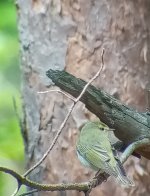I don't know any other bird watchers, how many actually carry around a spotting scope?
I actuall started with a scope, because I was regularly visiting a large nature reserve where the water birds were often 100m or more away. I bought a simple one on offer (20x-60x magnification) + cheap tripod (essential!) for under 200€, together with a plastic contraption (7€) which allowed me to take photos with it using my smartphone camera.
The first attempt was very frustrating. Apart from the fact that it's hard to actually get the bird you want in your frame at those distances, wobble is a tremendous problem. Even breathing on any part of the setup seemed to start the image jumping up and down, so releasing the shutter was just about impossible without blurring the image. A quick Google gave me the answer, and I invested a further 5€ in a remote Bluetooth button which solved the problem.
I realised over the next couple of trips that I'd have to change my birding tactics if I wanted decent photos. You can't wander around and take quick shots; it's much better to hunker down for a couple of hours and target a specific individual or species. It's good to find a naturally camouflaged spot, set up the equipment, focus on the place where you hope the bird will sit, and just wait. I've come to love this waiting however; you're not disturbing the habitat, so you'll also get loads of other birds and animals passing by. After a few outings I started getting the results I was wanting; here two examples:

I'd seen three Bullfinches here the day before, so I came back the next day, approached carefully and set up the scope on the tripod about 30m away from the fence where the birds had been regularly sitting. This guy came along after about 30 minutes and very accomodatingly sat perfectly still while I tried to get the focus perfect.

This Wood Warbler took a lot of patience! It would sit on a perch and sing for a couple of minutes, then fly to the next one and start over again. At first I was trying to follow it with the scope, but it never gave me enough time to focus. So after about an hour I changed position slightly and simply focussed on a branch on which it had already landed 4-5 times. It took another hour before it suddenly landed right in the centre of the viewfinder, and I was able to fire off about 20 shots before it moved on.
This sounds like a lot of faffing around with clumsy apparatus for low-quality pictures, and it is. But it can also provide great satisfaction!
I've since invested in a bridge camera (Panasonic Lumix FZ300) which I'm still getting to know. It's much handier for "normal" birding, and the picture quality is much higher; but I still take my scope if I'm going anywhere where the birds are likely to be at some distance, and it's definitely been worth the investment.









